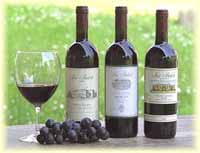Members of the wine
Tuscany Chianti Wine
Direct components of the wine
The wine is a food much complex, constituted gives approximately 300 components. Some of these components of the wine come directly from the grape and direct components maintain themselves also in the wine (); others components of the wine are substances with a structure that changes during the fermentativo process (indirect components). Direct components of the wine define themselves the substances that are found in the grapes. The main member is the water (that she constitutes approximately the 85-90% of the wine). Beyond to the water, the wine is constituted from several acids. The tartarico acid is characteristic above all in the young types wine. He is much resistant one to the bacteria and diminishes when the temperature of the wine is lowered; the sour and fresh taste just of the red wine of little months is given from the presence of this acid. The malico acid (than is found in the wine) is present in nature is in the leaves is in the fruits. It is found in the sour grape in sufficient amount to confer to the acini (assigns you to the crazione of the wine) a sour sapore. With the malolactic fermentation, than not always verification, the malico acid (present in the wine) comes transformed in lactic acid; the wine assumes sapore more garbato then and it is softened. The citric acid is present in the wine in smallest amounts and it is found is in must is in the wine. Between the direct components of the wine there are also the phenolic substances, that they confer to the wine color and taste. Also the tannins make part of the phenolic substances and are present in the peel, the graspo and the vinaccioli and consequently also in the wine. If their concentration is much elevating, confers to the wine a taste astringent, feeling similar to that one that provokes the sour fruit. The wine white man of it contains lower percentages regarding those of the red wine. In the wine they are moreover present sugars, in particular the glucose and the fructose, in almost equal percentages, with one minimal prevalence of fructose; they serve to balance possible traces of bitter presents in the wine left from other substances and to more confer to the wine taste or little cake. The minerals of the wine, that is the anions and the cationi, confer freschezza and sapore, beyond constituting of also ashes.
Indirect components of the wine
The substances are said indirect components of the wine that are found again alone in the wine and not in the grapes. Between these, the more important is the etilico alcohol that shape in the course of the fermentation of must; the etilico alcohol allows the wine to conserve itself in the time, also for various years. It is, moreover, the catalyst of all the olfattive feelings of the wine. The alcohol concentration in the wine of it establishes the alcoholic gradazione. The glycerin, or glicerolo, derives directly from the alcoholic fermentation of the wine and increases with increasing of the degree of maturation of the grapes until catching up the levels more elevates to you in case of withered clusters; it communicates to the wine vellutato, soft and harmonic taste. The succinico acid is developed during the fermentation of must and supplies to the wine particular, bitter and salato taste. The acetic acid has sour sapore and forms the acidity flown them of the wine.
